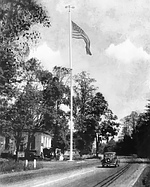Planes, Trains and Automobiles
Over the centuries, Palisades attracted many to move here because of its bucolic rural setting. As newcomers settled in, they joined the community in protecting our hamlet. Some were good persuaders of the powers that be - other times, not so much. In sum, though, they have kept Palisades from becoming a completely different place.
Imagine a railway along the western Hudson River shore. Incorporated in 1846, the Hudson River Railroad Company in time took about 130 miles of the eastern riverbank for their rail line. The success of that endeavor prompted the formation of the Hudson and West Shore Railroad Company. Its company President envisioned a railbed from Weehawken along the base of the Palisades to Haverstraw. In 1866 at least one bid offered a $120,000 contract for the Piermont to Weehawken portion and several property owners in Snedens Landing, hoping for ‘high speed’ transportation to the city, made agreements to sell shoreline and waterfront rights to the railroad. Local opposition and competition from the New York Central and the Erie Railroads proved too much, and this dream was never realized. Between 1870 and 1890, the amount of railroad track in the United States tripled, but none of it was along the Hudson shore in Palisades.
A century after any major rail projects were considered for our area, The New York Times reported on a 1993 Metro-North study for the Metropolitan Transportation Authority (MTA) suggesting a rail link across the Hudson River to connect Grand Central Station with Rockland and Orange counties. At the time, the rail commuter route from Port Jervis-Middletown-Suffern-Spring Valley to Hoboken, changing to the PATH for either the World Trade Center or 33rd Street, took almost three hours. Rail commutes of the same distance from Poughkeepsie or New Haven took about half that time. New crossing points were suggested: Nyack to Tarrytown or the Palisades Parkway to Hastings, reducing travel time from Suffern to Grand Central to about 45 minutes. Supporting data anticipated rail trips from the west side of the Hudson to Manhattan would jump 21 percent to 60 percent, removing 4,000 cars on the George Washington Bridge and 1,000 cars on the Tappan Zee. The Board of Trustees in Hastings was “vehemently opposed to any kind of bridge crossing from Palisades to Hastings or even a tunnel connection.” Neither materialized.
As rail travel declined early in the 20th century and automobiles became the preferred mode of transportation, the need for a national system of roadways developed. In 1926, the U.S. Highway System was approved and New York State, with Federal aid, started to acquire land along an unpaved road that ran from Sparkill to New Jersey Route 18N (which is now part of Long Path Trail in the Palisades Interstate Park). The mostly concrete, three-track pavement was completed first to Nyack and then to Albany, prompting news stories that proclaimed “all of Route 9W – the great highway on the west shore of the Hudson – is in the best condition in its history. ... [It] is the longest river highway in the East.” It started at the Holland Tunnel in Jersey City and ran north to Albany, more than 150 miles. About the same time, the Palisades Interstate Parkway was being planned. [See the article in the May 2016 issue of 10964.]
Imagine an airfield in Palisades. Some twenty years later, a Legal Notice appeared in The Journal News regarding a petition before the Orangetown Town Board to locate a private commercial airport in Palisades. The petitioners were World War II Army Air Corps veterans asking to amend the zoning to allow for a small airfield. The land, located on Route 9W, contained about 30 acres, excluding about an acre surrounding Dempsey’s tavern. At the public hearing in the Palisades School, Major Maurer, Civil Aeronautical Committee chairman and Civil Air Patrol leader, noted that there were no available airfields in the area [Christie Airport in New City would only allow pilots who purchased a plane or trained there]. Palisades with 2,500 feet of flat land atop the 400 foot cliffs lining the Hudson would make an excellent approach for small planes. A letter from Thomas Lamont to the Town Supervisor warned the airport would destroy the peace and quiet of Palisades, forcing “an exodus on the part of many people” who pay taxes and “contribute heavily to local charities and funds.” More than 100 people attended the hearing. Many questioned the pilots over the dangers of the airfield. Upon polling the 68 Palisades residents in attendance, 67 were opposed and the Town Board acceded to their wishes and denied the zone change.
No trains, no planes, just automobiles ...




